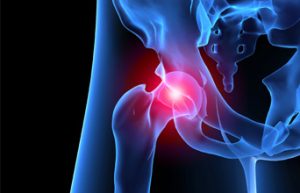This week, we feature a friend of Dr. Ashley Hoyt’s Key West Wellness Center, Dale Alexander.
____________________________________________________________________________________________
The hip joint is most often characterized as a ball and socket joint. The problem with the human hip is that the head of the femur bone (the ball) very often slides backward and starts riding the edge of its socket. Over the years, this wears a flat spot into the normally spherical shape of the femoral head. Also, when this slide occurs, it pulls on the tendon of a crucial muscle that moves the thigh forward when we walk. Again, over many years, this compresses the artery that feeds the femoral head.
These brief descriptions are the two most common reasons that people end up getting a hip replacement, osteoarthritis and avascular necrosis. The motion within a healthy hip joint is characterized by its ability to “roll and spin.” When the femoral head slips backward, these normal motions become less.
What appears to have eluded many is that the other end of the femur bone is where the
nibby knobs interface with depressions in the bone of the tibia, the (femoral condyles) and the (tibial plateaus). Together these moving surfaces comprise the knee joint. Most often when the femoral head slides backward, it also twists. This twist is communicated down the length of the bone influencing the tracking function between the opposing surfaces of the knee joint.
How the knee works is to twist between these surfaces to unlock the joint allowing it to bend and the thigh and leg to move forward. Then as a person’s heel and foot come down and pushes off and forward, the nibby knobs need to have twisted back into their originally locked position for one to have power in their stride and “pep to their step.”
As you might already imagine, if the entire femur bone is twisted from above, then the tracking of the knee joint will be affected. Compression and friction result. Arthritic changes are the outcome. Often calcium salts will build up and you both feel and hear the grinding within the knee joint. The same elements of compression and friction are what erode the hip joint’s function resulting in pain and loss of motion in either the knee or the hip.
Sadly, women have almost double the number of knee replacements and slightly more hip replacements than men. This is usually explained by the fact that the female pelvis is wider to allow for childbirth, thus they have more of an angle between the two ends of the femur bone by the time they reach childbearing maturity.
Nature simply has not been fair. It serves its purposes by selecting for physical traits that maximize its species ability to survive and thrive.
Early detection of hip or knee degeneration is essential. If you have a “hitch in your get a long” or pain while walking, you need to seek treatment and/or orthopedic evaluation.
Please see Dr. Ashley Hoyt or myself. If we are unable to to assist you then we will refer you to a physician we trust.
_________________________________________________________________________________________
Dale G. Alexander Ph.D. L.M.T. has had a Clinical Massage Therapy practice in Key West, Fla. for 35 years now. In 1983 he was hit head-on by a drunken driver along the 18 mile stretch going south toward Key Largo at Jewfish Creek Bridge. Among many injuries, his right hip was shattered. Very soon after rehabilitating his injuries, clients began showing up in increasing numbers that had varying stages of hip, knee, and shoulder degeneration. Dale invites anyone who has a chronic problem with any of these joints to call him for a free consultation. You may access his published articles on this subject at www.massagetoday.com. Click on columnists, then on his name. And, visit his website, www.dale-alexander.com to review his extensive training history and to appreciate the broader scope of the people he has helped.


